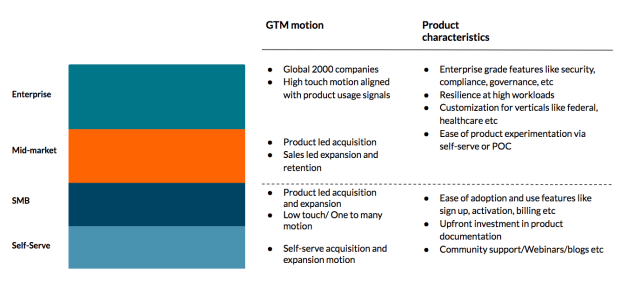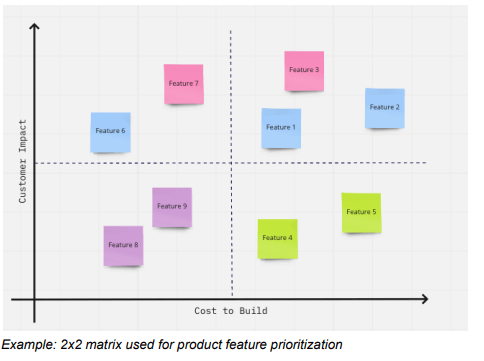The rise of the product-led growth business model (especially in software categories catering to developer economy) has changed the way traditional Go-to-Market (GTM) functions interact with product management.
Regardless of whether a B2B company adopts a ‘sales led’, ‘product led’ or ‘hybrid product led, sales assisted model, product managers play a pivotal role in providing an x-functional linkage between customers, sales and marketing org and engineers. In this post, Ankur Goel lists 6 critical ways that the best product managers provide the necessary linkage and add value in his guest post.
Link product roadmap with GTM segmentation
One of the most important decisions a GTM leader needs to make is on how to segment/specialize the sales and marketing resources. Typically, segmentation is done by company size i.e., ENT vs SMB, industry vertical (finance, public sector etc) and/or geography. In many companies, these decisions are taken in a silo by GTM teams without taking into consideration the product considerations – for e.g., is the product ready to support different segments or if there is enough differentiation in the product roadmap to appeal to different sets of customers. This results in wasted effort, loss of motivation and missed sales quota.
A better approach is to anticipate specialization/segmentation a few quarters in advance and proactively work with product managers to understand the roadmap that would support the segmentation. This will allow a more sustainable growth path and would reduce inefficient use of resources. Stakes are even higher if the intended business model is to be product led especially for the SMB/self-serve segment. ENT customers require significant investments in security, compliance and governance-related features. However, a product-led motion requires investment in product experience, ease of use and ‘freemium’ style features which might require a completely different org structure for proper execution.
Another example is public sector or regulated industries that require specific certifications and investments in security features etc before meaningful sales.
Define product adoption metrics as leading indicators of revenue
Various engineering teams like to measure success on the basis of features shipped or the reliability of the product/service. Although this is important, they are not a sufficient criterion for success in the world of hybrid product-led, sales-assisted motion. Before expanding further, let us discuss key attributes that are shared by these motions:
1. Product-led: the focus is on getting potential customers to use or adopt the product (typically free) before upselling/cross-selling additional features
2. Usage-based or consumption-driven: it’s not enough to sell the product, you need to ensure a customer is using it and deriving value to realize revenue
A combination of #1 and #2 leads to higher customer acquisition costs upfront which are typically recouped by high customer lifetime value based on usage and expansion of product
The above factors mean that it is no longer enough to track product releases or set targets based on a theoretical understanding of how customers should be using the product. It is essential to track how customers are actually using the product so customer GTM teams can figure out strategies to unlock additional usage.
For example, Confluent started its journey as an on-premise solution to monetize open-source Kafka. In the early days, it had limited ability to understand how the customer was using its product beyond insights gained via initial provisioning. This completely changed when Confluent introduced a cloud product that allowed a more granular understanding of how customers used various features within Confluent’s suite of products. This increased accountability on product and engineering managers and made them focused on not just shipping new features but on increasing the overall adoption/revenue of their individual products
Another example is LinkedIn which realized that tracking DAUs/MAUs was an important but not necessary indicator of whether a customer was deriving value from their enterprise products. They tasked a cross-functional team led by a product manager to define a new metric that could
prove to be a leader in both customer retention and expansion thus providing sales teams with additional intel on how to engage with customers.
Set up a process early to capture customer feedback from GTM teams and align on prioritization framework
One of the key tasks of a product manager is to collect feedback from not only customers but also various GTM teams to understand which features are in high demand and need to be prioritized.
Anyone who has interacted with sales teams knows that pressure to prioritize 1-2 customers can be disruptive to thinking about the overall product roadmap. Consequently, it’s essential to align early on with the GTM organization on a framework and process that will be used to prioritize different feature requests across various product areas to minimize disruption.
Generally, product operations can lead the charge here to define/run a process but ultimately it is the job of product managers to drive alignment. Absent of this, there is a danger of product org becoming very reactive to the GTM needs vs being opinionated and providing leadership. In one of my previous companies, this lack of trust in the prioritization process created a very adversarial culture between product and GTM organisation resulting in various sub-optimal decisions and loss of morale before the executives stepped in to create a shared framework.
Align early with engineering to understand resource availability
There are various reasons for delays in product release, one of the main ones is misalignment between product and engineering on the capacity that is available to work on new features vs paying down tech debt vs maintenance/servicing existing customers. This leads to over-ambitious release targets early on which need to be tempered down over time thus leading to product delays and lack of trust.
One of the ways to eliminate this issue is by proactively understanding the available capacity and fungibility of resourcing. The best way I have seen this done is by dividing up each team’s resourcing into different buckets – new features vs maintenance vs keep the lights on + indicating which teams might have the capacity to move teams/roles if needed based on shifting product priority. This exercise, while providing a realistic picture of engineering capacity, leads to a much more robust planning process since it allows a two-way conversation that leads to better scope definition and less disruption due to missed deadlines in future.
| % of resourcing | Team 1 Team 2 |
| New features | 20% 30% |
| Maintenance | 40% 60% |
| Keep the lights on | 40% 10% |
Show ownership to drive messaging and pricing
In a B2B company, product marketing plays a crucial role in figuring out strategies, messaging and content that are essential for taking a product to market. They also create content for enabling the sales teams and run campaigns to increase brand awareness/generate demand for the product. Product managers, being the subject matter experts, are important stakeholders who need to proactively work with the marketing folks to ensure an appropriate messaging framework is being transmitted to customers and salespersons.
Since product and marketing are typically in different org structures, there is a tendency for lack of collaboration and siloed execution. In a fast-growth environment, this could have serious consequences for the business as a whole. Best product managers are aware of these dynamics and proactively think about messaging and positioning as they are building the product roadmap. Having an ‘ownership’ mindset helps to set the right tone early on thus ensuring smooth functioning.
In a consumption-driven environment where pricing is usage-based, having the product team own pricing has led to a lot of success. The reason is that pricing-related features (billing infrastructure, user experience) are closely integrated with the product and require technical expertise to ensure smooth experimentation, roll out and implementation.
Adopt a GTM mindset
While consumer technology companies have pioneered product managers as a GTM for a long time (think Google, LinkedIn etc), the mindset of product managers in enterprise companies has been very different. They have generally focused on product and technical aspects while leaving questions around monetization, adoption, revenue etc to GTM teams. This mindset is a legacy of traditional sales led enterprise motion where salespersons owned the relationship with C-level execs who were the key decision makers and buyers of software. In the age of cloud and developer-led economy, the dynamic has completely changed. Most companies now strive for a hybrid motion where the product is already adopted and ‘road-tested’ by the target end-user. Many end-users are able to spend money on the product/platform before sales is brought in to negotiate larger deals with senior executives.
This new dynamic calls for a very different mindset from the product managers. They have to become front and center of the entire product experience and develop relationships with a community of customers (via talks, webinars, meetings) like never before. In addition, a lot of decisions related to product positioning, growth and pricing are also led by the product managers. Only by taking an end-to-end approach (from engineering to GTM monetization) can they be successful in maximizing the product potential with different set of internal and external stakeholders
In conclusion, the role of the product manager requires a unique skillset. They not only serve as customer advocates but also act as a bridge between engineering (that makes the product) and GTM functions (that sells the product). The rise of the hybrid product-led and sales-assisted motion in B2B setting has further changed the dynamic and now demands a product manager who understands the business end-to-end and can bring an integrated GTM mindset to enable overall business success.
Hopefully this article provides readers with a playbook to implement some of the strategies that could lead to sustainable GTM success – wishing everyone the best of luck in their journey!









